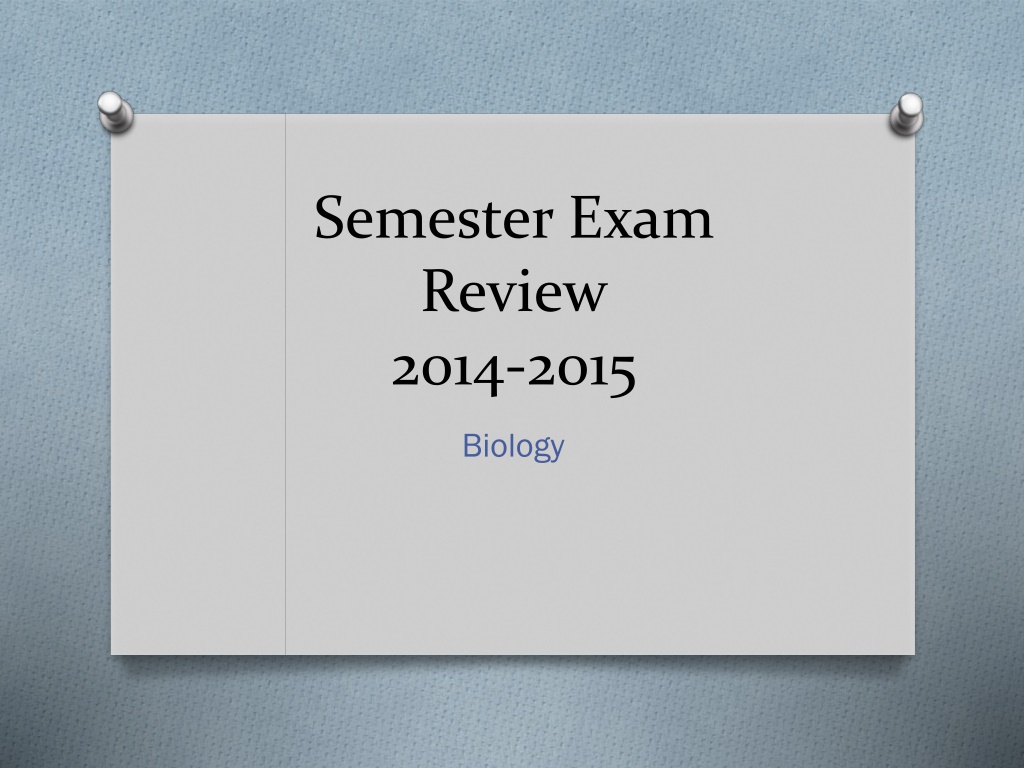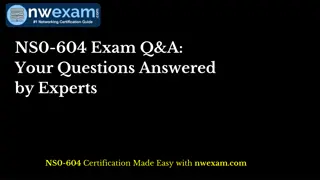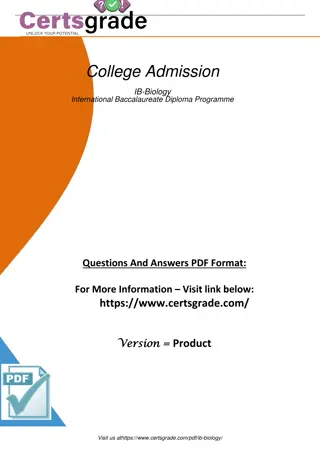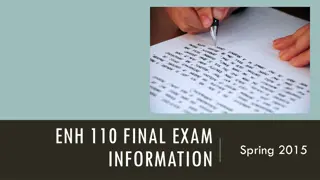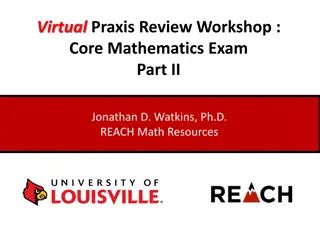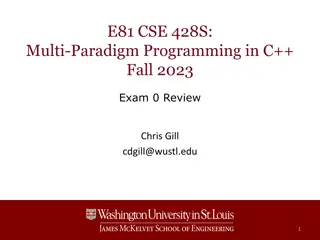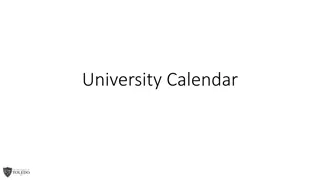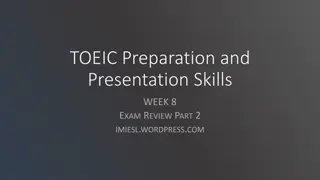Biology Semester Exam Review 2014-2015 Questions
This biology semester exam review from 2014-2015 covers various topics including prokaryote and eukaryote cells, osmosis, cell size changes in solutions, and impacts of different environments on organisms. Questions are focused on cell structures, functions, and interactions with their surroundings.
Download Presentation

Please find below an Image/Link to download the presentation.
The content on the website is provided AS IS for your information and personal use only. It may not be sold, licensed, or shared on other websites without obtaining consent from the author. Download presentation by click this link. If you encounter any issues during the download, it is possible that the publisher has removed the file from their server.
E N D
Presentation Transcript
Semester Exam Review 2014-2015 Biology
Question #1 Which of the following statements is true about prokaryote and eukaryote cells? A. They both have membrane bound organelles B. They both have a nuclear membrane C. They both have circular chromosomes D. They both have a cell membrane
Question #2 The solution in the diagram to the right contains 93% water and 7% sugar. The animal cell in the solution is 99% water and 1% sugar. Which statement best describes how osmosis will affect the animal cell? A. Sugar will move into the cell and the cell will expand B. Sugar will move out of the cell and the cell will expand C. Water will move into the cell and the cell will expand D. Water will move out of the cell and the cell will shrink
Question #3 When a slice of potato was placed in a solution. When the potato was taken out, the potato slice had increased in size. The solution is said to be: A. Hypertonic B. Hypotonic C. Isotonic D. None of the above
Question #4 The sodium chloride (NaCl) concentration of a normal human blood cell is 0.9%. The picture to the left shows normal red blood cells while the picture to the right shows red blood cells in a solution. In order for the cell to burst how must the concentration of salt be in the solution? Higher than the concentration of salt in the cell Lower than the concentration of salt in the cell Equal to the concentration of salt in the cell A. B. C.
Question #5 The picture on the right illustrates: A. Diffusion B. Facilitated Diffusion C. Active Transport D. Osmosis
Question #6 The picture on the right illustrates: A. Diffusion B. Facilitated Diffusion C. Active Transport D. Osmosis
Question #7 The picture on the right illustrates: A. Diffusion B. Facilitated Diffusion C. Active Transport D. Osmosis
Question #8 Organisms in a freshwater ecosystem can be negatively impacted if they are placed in a saltwater ecosystem because they were placed into a: A. hypertonic solution and too much water was being brought into their cells. B. hypertonic solution and too much water was leaving their cells. C. hypotonic solution and too much water was being brought into their cells. D. hypotonic solution and too much water was leaving their cells.
Question #9 Based on the cell theory, why is a virus considered non-living? A. A virus cannot reproduce itself without a host cell B. A virus does not have a nucleus C. A virus does not contain genetic material D. A virus is too small to be considered a cell
Question #10 A university professor finds a particle not visible by the unaided eye. It has the shape of a soccer ball. It is non cellular but it has a DNA core. The core is trapped in s capsid and the capsid has spike-like projections on its surface. This particle could be: Protist Eubacteria Virus D. Archaebacteria A. B. C.
Question #11 Which type of viral reproduction takes place when the influenza virus attacks a person? A. Binary fission B. Conjugation C. Lytic D. Lysogenic
Question #12 Equation 1: 6CO Equation 1: 6CO2 2+ 6H What process does the reaction above represent? A. Protein synthesis B. Cell Respiration C. Photosynthesis D. Dehydration synthesis + 6H2 2O + sunlight 6O O + sunlight 6O2 2+ C + C6 6H H12 12O O6 6
Question #13 Equation 2: 6O Equation 2: 6O2 2+ C What process does the reaction above represent? A. Protein synthesis B. Cell Respiration C. Photosynthesis D. Dehydration synthesis + C6 6H H12 12O O6 6 6CO 6CO2 2+ 6H + 6H2 2O + energy O + energy
Question #14 What are the reactants in the process of cell respiration? A. Carbon dioxide, water and energy B. Carbon dioxide, water and light C. Oxygen and glucose D. Oxygen and water
Question #15 Which biomolecule that contains Carbon, Hydrogen and Oxygen in a 1:2:1 ratio is used as the primary source of energy? A. Fats B. Carbohydrates C. Proteins D. Nucleic acids
Question #16 Like complex carbohydrates, proteins are biomolecules that serve many functions and can be chemically broken down and restructured. Which statement describes proteins and complex carbohydrates? A. They are both nucleotides of DNA B. They are both sequences of sugars C. They are both lipids of large molecules D. They are both polymers of smaller subunits
Question #17 What is the basic unit (monomer) of DNA? A. Nucleotide B. Monosaccharide C. Fatty acid D. Amino acid
Question #18 Which molecule of RNA carries the coding information to the site of protein synthesis? A. rRNA B. tRna C. sRNA D. mRNA
Question #19 In a DNA molecule, what determines the traits (characteristics) of an organism? A. Strength of the hydrogen bonds B. Amount of adenine C. Number of sugars D. Sequence of nitrogen bases
Question #20 In the illustration to the right, what are the missing complementary bases going from top to bottom? A. T-A-A-T B. U-C-C-U C. A-G-G-A D. T-C-C-T
Question #21 Before DNA can replicate, where must the DNA strand separate? Between every phosphate sugar pair Between any two chemical bonds Between the eight sugar base pairs D. Between every nitrogenous base pair A. A. B. B. C. C.
Question #22 What is produced in the diagram below? A. Fatty acid B. Protein C. Glucose D. Nucleotides
Question #23 Look at the 2 nucleotide sequences below. Sequence 2 is a mutated copy of sequence 1. What type of mutation is represented in sequence 2? A. Point mutation B. Inversion mutation C. Insertion mutation D. Deletion mutation Sequence 1: GAC CCG AUG Sequence 1: GAC CCG AUG Sequence 2: GAC GCC GAU Sequence 2: GAC GCC GAU
Question #24 A DNA analysis was done on several suspects of a crime that was committed. The results are pictured below. Who committed the crime? A. Suspect A B. Suspect B C. Suspect C D. None of the suspects are a DNA match
Question #25 One way in which a point mutation and a deletion mutation are different is that ... A. a point mutation is a physical change, and a deletion mutation is a chemical change. B. a point mutation is always harmful, and a deletion mutation is never harmful. C. a point mutation only changes one single nucleotide base, while a deletion mutation results in a frameshift of all the bases that follow D. a point mutation always results in a frame shift mutation, while a deletion mutation never results in a frameshift mutation.
Question #26 A white flower is crossed with a red flower. All the offspring are pink. This is an example of: A. Polygenic inheritance B. Multiple alleles C. Incomplete dominance D. Codominance
Question #27 The karyotype below illustrates: A. Abnormal female B. Abnormal male C. Normal female D. Normal male
Question #28 In guinea pigs, the allele for a rough coat (R) is dominant for the allele for a smooth coat (r). A heterozygous guinea pig and a homozygous recessive guinea pig are mated. Which of the following lists the distribution of genotypes most likely to be seen in the offspring? A. 25% RR, 50% Rr, and 25% B. 75% Rr and 25% rr C. C. 100% Rr D. 50% Rr and 50% rr
Question #29 In cats, the gene for brown fur (B) is dominant over the gene for white fur (b). Which set of genotypes represents a cross of two brown cats that could produce offspring with white fur? A. Bb bb B. Bb Bb C. BB x Bb D. BB x bb
Question #30 Research has shown that this uncontrolled cell growth and development can lead to which of these diseases? A. Down syndrome B. Cancer C. Hemophilia D. AIDS
Question #31 Himalayan rabbits carry a gene that is inactive above 35 C, and it is most active from 15 C to 25 C. This produces rabbits with a specific coat coloring. In the central parts of the rabbit s body where it has the highest temperature, the gene is not active, and no pigments are produced, resulting in white fur. However, in the rabbit's ears, tip of the nose, and feet, where the temperature is much lower than 35 C, the gene actively produces pigment which results in black fur. This experiment suggests that temperature may affect the feeding habits of Himalayan rabbits temperature may affect gene expression in Himalayan rabbits Himalayan rabbits will all look identical to one another abnormalities among Himalayan rabbits are common A. B. B. C. C. D. D.
Question #32 The segregation that occurs during meiosis results in: A. Group of identical cells B. Single fertilized egg cell C. Decrease in number of cells per organism D. Reduction in the number of chromosomes per cell
Question #33 Identify the correct order of the events in the diagram below: D C B A A B C D B C D A A. B. C. D. A B D C
Question #34 Sex cells are produced by means of _______ while additional body cells are produced by the means of __________. A. Mitosis; meiosis B. Meiosis; mitosis C. Mitosis; conjugation D. Meiosis; gametogenesis
Question #35 Which of the following is the correct order for the cell cycle? A. Interphase, metaphase, cytokenisis, prophase, telophase, anaphase. B. B. Anaphase, interphase, metaphase, cytokenisis, telophase, prophase. C. C. Interphase, prophase, metaphase, anaphase, telophase, cytokenisis. D. D. Prophase, metaphase, anaphase, interphase, telophase, cytokenisis.
Question #36 Waxy coating on plants is a: A. Lipid B. Carbohydrate C. Protein D. Nucleic acid
Question #37 The process in the diagram below illustrates: A. Exocytosis B. Endocytosis C. Osmosis D. Diffusion
Question #38 The molecule below is: A. Fat B. Carbohydrate C. Nucleic acid D. Protein
Question #39 Enzymes speed up chemical reactions by: A. Changing the pH of a solution B. Making more bonds C. Increasing the activation energy D. Decreasing the activation energy
Question #40 Which is an example of homeostasis? A. A frog croaking to attract a mate B. A worker bee protecting the queen C. A lizard changing colors to camouflage D. A man sweating after a long run
Question #41 A cell wall is to bacteria as a _____________ is to a virus. A. Cell membrane B. Nucleus C. Spindle fibers D. Capsid
Question #42 Which statement best describes the primary function of DNA replication? to prevent mutations from occurring in cells to ensure daughter cells have a complete copy of the DNA to provide genetic variation within specific organisms D. to allow prokaryotic cells to undergo meiosis A. B. C.
Question #43 What does the diagram represent? A. plant cell forming a cleavage furrow animal cell forming a cell plate animal cell forming a cleavage furrow plant cell forming a cell plate B. C. D.
Question #44 Identify X Y Z A A. X = substrate, Y = active site, Z = enzyme B B. X = active site, Y = enzyme, Z = product C C. X = enzyme, Y = reactant, Z = substrate D D. X = reactants, Y = substrate, Z = active site
Question #45 Which of the following organelles would be found in both prokaryote and eukaryote cells? A. Ribosomes B. Chloroplast C. Cell wall D. nucleus
Question #46 Mutations in the DNA sequence produce: A. Changes in the phenotype B. A harmful impact C. A positive impact D. Genetic diversity
